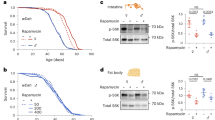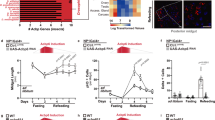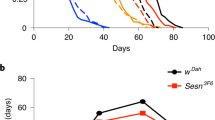Abstract
Tissue integrity is contingent on maintaining stem cells. Intestinal stem cells (ISCs) over-proliferate during ageing, leading to tissue dysplasia in Drosophila melanogaster. Here we describe a role for white, encoding the evolutionarily conserved ATP-binding cassette transporter subfamily G, with a particularly well-characterized role in eye colour pigmentation, in ageing-induced ISC proliferation in the midgut. ISCs increase expression of white during ageing. ISC-specific inhibition of white suppresses ageing-induced ISC dysregulation and prolongs lifespan. Of the proteins that form heterodimers with White, Brown mediates ISC dysregulation during ageing. Metabolomics analyses reveal previously unappreciated, profound metabolic impacts of white inhibition on organismal metabolism. Among the metabolites affected by White, tetrahydrofolate is transported by White, is accumulated in ISCs during ageing and is indispensable for ageing-induced ISC over-proliferation. Since Thomas Morgan’s isolation of a white mutant as the first Drosophila mutant, white mutants have been used extensively as genetic systems and often as controls. Our findings provide insights into metabolic regulation of stem cells mediated by the classic gene white.
This is a preview of subscription content, access via your institution
Access options
Access Nature and 54 other Nature Portfolio journals
Get Nature+, our best-value online-access subscription
$29.99 / 30 days
cancel any time
Subscribe to this journal
Receive 12 digital issues and online access to articles
$119.00 per year
only $9.92 per issue
Buy this article
- Purchase on Springer Link
- Instant access to full article PDF
Prices may be subject to local taxes which are calculated during checkout






Similar content being viewed by others
Data availability
Source data are provided with this paper. All other data that support the findings are available within the paper.
References
Micchelli, C. A. & Perrimon, N. Evidence that stem cells reside in the adult Drosophila midgut epithelium. Nature 439, 475–479 (2006).
Ohlstein, B. & Spradling, A. The adult Drosophila posterior midgut is maintained by pluripotent stem cells. Nature 439, 470–474 (2006).
Liang, J., Balachandra, S., Ngo, S. & O’Brien, L. E. Feedback regulation of steady-state epithelial turnover and organ size. Nature 548, 588–591 (2017).
Biteau, B., Hochmuth, C. E. & Jasper, H. JNK activity in somatic stem cells causes loss of tissue homeostasis in the aging Drosophila gut. Cell Stem Cell 3, 442–455 (2008).
Choi, N. H., Kim, J. G., Yang, D. J., Kim, Y. S. & Yoo, M. A. Age-related changes in Drosophila midgut are associated with PVF2, a PDGF/VEGF-like growth factor. Aging Cell 7, 318–334 (2008).
Regan, J. C. et al. Sex difference in pathology of the ageing gut mediates the greater response of female lifespan to dietary restriction. eLife 5, e10956 (2016).
Koehler, C. L., Perkins, G. A., Ellisman, M. H. & Jones, D. L. Pink1 and Parkin regulate Drosophila intestinal stem cell proliferation during stress and aging. J. Cell Biol. 216, 2315–2327 (2017).
Jiang, H. et al. Cytokine/Jak/Stat signaling mediates regeneration and homeostasis in the Drosophila midgut. Cell 137, 1343–1355 (2009).
Hudry, B., Khadayate, S. & Miguel-Aliaga, I. The sexual identity of adult intestinal stem cells controls organ size and plasticity. Nature 530, 344–348 (2016).
Morgan, T. H. Sex-limited inheritance in Drosophila. Science 32, 120–122 (1910).
Platts, A. E. et al. Massively parallel resequencing of the isogenic Drosophila melanogaster strain w1118; iso-2; iso-3 identifies hotspots for mutations in sensory perception genes. Fly 3, 192–203 (2009).
Bingham, P. M. The regulation of white locus expression: a dominant mutant allele at the white locus of Drosophila melanogaster. Genetics 95, 341–353 (1980).
Hazelrigg, T., Levis, R. & Rubin, G. M. Transformation of white locus DNA in drosophila: dosage compensation, zeste interaction and position effects. Cell 36, 469–481 (1984).
Ziehm, M., Piper, M. D. & Thornton, J. M. Analysing variation in Drosophila aging across independent experimental studies: a meta-analysis of survival data. Aging Cell 12, 917–922 (2013).
Lauwers, G. Y. & Riddell, R. H. Gastric epithelial dysplasia. Gut 45, 784–790 (1999).
Tarr, P. T., Tarling, E. J., Bojanic, D. D., Edwards, P. A. & Baldan, A. Emerging new paradigms for ABCG transporters. Biochim. Biophys. Acta 1791, 584–593 (2009).
Theodoulou, F. L. & Kerr, I. D. ABC transporter research: going strong 40 years on. Biochem. Soc. Trans. 43, 1033–1040 (2015).
Ewart, G. D. & Howells, A. J. ABC transporters involved in transport of eye pigment precursors in Drosophila melanogaster. Methods Enzymol. 292, 213–224 (1998).
Borycz, J., Borycz, J. A., Kubow, A., Lloyd, V. & Meinertzhagen, I. A. Drosophila ABC transporter mutants white, brown and scarlet have altered contents and distribution of biogenic amines in the brain. J. Exp. Biol. 211, 3454–3466 (2008).
Evans, J. M., Day, J. P., Cabrero, P., Dow, J. A. & Davies, S. A. A new role for a classical gene: white transports cyclic GMP. J. Exp. Biol. 211, 890–899 (2008).
Sitaraman, D. et al. Serotonin is necessary for place memory in Drosophila. Proc. Natl Acad. Sci. USA 105, 5579–5584 (2008).
Sullivan, D. T., Bell, L. A., Paton, D. R. & Sullivan, M. C. Purine transport by malpighian tubules of pteridine-deficient eye color mutants of Drosophila melanogaster. Biochem. Genet. 17, 565–573 (1979).
Sullivan, D. T., Bell, L. A., Paton, D. R. & Sullivan, M. C. Genetic and functional analysis of tryptophan transport in Malpighian tubules of Drosophila. Biochem. Genet. 18, 1109–1130 (1980).
Sullivan, D. T. & Sullivan, M. C. Transport defects as the physiological basis for eye color mutants of Drosophila melanogaster. Biochem. Genet. 13, 603–613 (1975).
Tejeda-Guzman, C. et al. Biogenesis of zinc storage granules in Drosophila melanogaster. J. Exp. Biol. https://doi.org/10.1242/jeb.168419 (2018).
Zeng, X., Chauhan, C. & Hou, S. X. Characterization of midgut stem cell- and enteroblast-specific Gal4 lines in drosophila. Genesis 48, 607–611 (2010).
Miguel-Aliaga, I., Jasper, H. & Lemaitre, B. Anatomy and physiology of the digestive tract of Drosophila melanogaster. Genetics 210, 357–396 (2018).
Nicholson, L. et al. Spatial and temporal control of gene expression in drosophila using the inducible GeneSwitch GAL4 system. Screen for larval nervous system drivers. Genetics 178, 215–234 (2008).
Biteau, B. et al. Lifespan extension by preserving proliferative homeostasis in Drosophila. PLoS Genet. https://doi.org/10.1371/journal.pgen.1001159 (2010).
Mathur, D., Bost, A., Driver, I. & Ohlstein, B. A transient niche regulates the specification of Drosophila intestinal stem cells. Science 327, 210–213 (2010).
Ferreiro, M. J. et al. Drosophila melanogaster white mutant w1118 undergo retinal degeneration. Front. Neurosci. 11, 732 (2017).
Xiao, C. F., Qiu, S. & Robertson, M. The white gene controls copulation success in Drosophila melanogaster. Sci. Rep. https://doi.org/10.1038/s41598-017-08155-y (2017).
Parkhitko, A. A. et al. Tissue-specific down-regulation of S-adenosyl-homocysteine via suppression of dAhcyL1/dAhcyL2 extends health span and lifespan in Drosophila. Genes Dev. 30, 1409–1422 (2016).
Silicheva, M. et al. Drosophila mini-white model system: new insights into positive position effects and the role of transcriptional terminators and gypsy insulator in transgene shielding. Nucleic Acids Res. 38, 39–47 (2010).
Tearle, R. Tissue specific effects of ommochrome pathway mutations in Drosophila melanogaster. Genet. Res. 57, 257–266 (1991).
Hochmuth, C. E., Biteau, B., Bohmann, D. & Jasper, H. Redox regulation by Keap1 and Nrf2 controls intestinal stem cell proliferation in Drosophila. Cell Stem Cell 8, 188–199 (2011).
Zheng, Y. & Cantley, L. C. Toward a better understanding of folate metabolism in health and disease. J. Exp. Med. 216, 253–266 (2019).
Zhao, R., Diop-Bove, N., Visentin, M. & Goldman, I. D. Mechanisms of membrane transport of folates into cells and across epithelia. Annu Rev. Nutr. 31, 177–201 (2011).
Ifergan, I. & Assaraf, Y. G. Molecular mechanisms of adaptation to folate deficiency. Vitam. Horm. 79, 99–143 (2008).
Guo, L., Karpac, J., Tran, S. L. & Jasper, H. PGRP-SC2 promotes gut immune homeostasis to limit commensal dysbiosis and extend lifespan. Cell 156, 109–122 (2014).
Resnik-Docampo, M. et al. Tricellular junctions regulate intestinal stem cell behaviour to maintain homeostasis. Nat. Cell Biol. 19, 52–59 (2017).
Rera, M. et al. Modulation of longevity and tissue homeostasis by the Drosophila PGC-1 homolog. Cell Metab. 14, 623–634 (2011).
Enokizono, J., Kusuhara, H. & Sugiyama, Y. Regional expression and activity of breast cancer resistance protein (Bcrp/Abcg2) in mouse intestine: overlapping distribution with sulfotransferases. Drug Metab. Dispos. 35, 922–928 (2007).
Ding, X. W., Wu, J. H. & Jiang, C. P. ABCG2: a potential marker of stem cells and novel target in stem cell and cancer therapy. Life Sci. 86, 631–637 (2010).
Vijg, J. & Kennedy, B. K. The essence of aging. Gerontology 62, 381–385 (2016).
Lopez-Otin, C., Blasco, M. A., Partridge, L., Serrano, M. & Kroemer, G. The hallmarks of aging. Cell 153, 1194–1217 (2013).
Redhai, S. et al. An intestinal zinc sensor regulates food intake and developmental growth. Nature 580, 263–268 (2020).
Ebisch, I. M., Thomas, C. M., Peters, W. H., Braat, D. D. & Steegers-Theunissen, R. P. The importance of folate, zinc and antioxidants in the pathogenesis and prevention of subfertility. Hum. Reprod. Update 13, 163–174 (2007).
Yoo, S. K. et al. Plexins function in epithelial repair in both Drosophila and zebrafish. Nat. Commun. 7, 12282 (2016).
Yamada, T. et al. The role of glycogen in development and adult fitness in Drosophila. Development https://doi.org/10.1242/dev.176149 (2019).
Xia, J., Psychogios, N., Young, N. & Wishart, D. S. MetaboAnalyst: a web server for metabolomic data analysis and interpretation. Nucleic Acids Res. 37, W652–W660 (2009).
Acknowledgements
We thank H. Jasper, K. Akagi, L. Partridge, N. Perrimon, S. Hou, I. Hariharan, E. Kuranaga, S. Hayashi and S. Davies, and TRiP at Harvard Medical School, the Bloomington Stock Center and the Kyoto Stock Center for transgenic fly stocks. We thank the members of the Yoo laboratory, L. Yang and Y.-C. Wang for helpful comments on the manuscript. This work was supported by AMED-PRIME (17939907) and JSPS KAKENHI (JP16H06220) to S.K.Y. and JSPS KAKENHI (JP17H03658) to T.N.
Author information
Authors and Affiliations
Contributions
S.K.Y. conceived and oversaw the project. A.S., T.N., T.T., S.N. and S.K.Y. executed the experiments. A.S., T.T., S.N. and S.K.Y. contributed expertise in ISC regulation and ageing. T.T. and T.N. contributed expertise in metabolic analysis. S.K.Y. wrote the paper with input from all authors.
Corresponding author
Ethics declarations
Competing interests
The authors declare no competing interests.
Additional information
Peer review information Nature Metabolism thanks Bart Deplancke and the other, anonymous, reviewer(s) for their contribution to the peer review of this work. Primary Handling Editors: Pooja Jha; Isabella Samuelson.
Publisher’s note Springer Nature remains neutral with regard to jurisdictional claims in published maps and institutional affiliations.
Extended data
Extended Data Fig. 1 ISCs overproliferate in both males and females in a white-dependent manner during ageing.
a, ISC proliferation during ageing in males. b, ISC proliferation during ageing in females. Note that ISCs in females proliferate more than those in males regardless of age and genetic background. c, Females have more mitotic ISCs per gut (left), bigger guts (middle) and more mitotic ISCs per unit area (right) than males regardless of age. Progeny from crosses between female Oregon R and male w1118 were used for this analysis. d, Male progeny from crosses between Oregon R and w1118 have the same autosomes but different sex chromosomes. e, The male progeny with endogenous white exhibit ageing-induced ISC proliferation but those without white do not. f, Male progeny from crosses between Oregon R and w1 were used to examine ISC proliferation during ageing. g, w1 Oregon R flies do not demonstrate ISC dysregulation during ageing. h, Paraquat or DSS induces comparable ISC proliferation in Oregon R and wOregon R flies. Statistical significance was determined using two-tailed unpaired t-test (a, b, e, f, g), two-tailed Mann Whitney test (c) and one-way ANOVA with Dunnett’s post-test (h).
Extended Data Fig. 2 white regulates ISC homeostasis cell autonomously during ageing.
a, RT-qPCR of white transcript from Oregon R and w1118 demonstrates specificity of the designed primers for white. b, RT-qPCR of white transcript in the midgut of Oregon R shows that white transcription is not induced by paraquat treatment. c, Ubiquitous knockdown of white using act-Gal4, UAS-white RNAis shows that only one RNAi (BL33623) among 9 RNAi examined makes the eyes white, demonstrating an efficient knockdown of white. This effective RNAi (BL33623) was used to knockdown white throughout this paper. d, white knockdown in ISCs/EBs suppresses the ageing-induced increase of the number of ISCs. e, Representative pictures of esg>GFP positive cells (ISCs and EBs) in the midgut. Scale bar, 50 um. f, Ectopic expression of white does not promote ISC proliferation in young flies. g, Lifespan of Oregon R and wOregon R. In contrast to the effect of ISC-specific white knockdown (Fig. 2i), white knockout in the whole body does not extend lifespan. h, Lifespan of flies with ubiquitous knockdown of white. Consistent with the knockout phenotype, ubiquitous knockdown of white does not extend lifespan. Statistical significance was determined using two-tailed unpaired t-test (a, b, d) and Log-rank (Mantel-Cox) test (g, h). The experiments were repeated independently at least twice with similar results (e).
Extended Data Fig. 4 Metabolomics of the carcass and the midgut.
a, Principal component (PC) analysis of water-soluble metabolites from the carcass (whole body without the gut) and the gut of Oregon R and wOregon R. The age of young (YG) and old male flies are 7 days and 1.5 months old, respectively. Ellipses of clusters show the 95% confidence regions for each sample group. b, Representative white-related metabolites are presented.
Extended Data Fig. 5 brown affects ISC homeostasis during ageing.
a, In contrast to Oregon R and st1, bw1 mutants do not exhibit ageing-induced ISC proliferation. b, RU486 extends lifespan of flies with 5961-GS, UAS-brown RNAi. Statistical significance was determined using two-tailed unpaired t-test (a) and Log-rank (Mantel-Cox) test (b).
Extended Data Fig. 6 Purine metabolism does not affect ISC homeostasis.
a, Purine catabolism pathway. Hydrogen peroxide is generated during conversion of hypoxanthine to xanthine and xanthine to uric acid. b, ISCs proliferate during ageing in rosy mutant rosy506 flies. c, Feeding xanthine or guanosine does not promote ISC proliferation in young flies. Statistical significance was determined using two-tailed unpaired t-test (b) and one-way ANOVA with Dunnett’s post-test (c).
Extended Data Fig. 7 Folate metabolism regulates white-mediated ISC proliferation during ageing.
a, Yeast depletion through feeding only sucrose lowers THF signals in the gut while feeding exogenous THF increases them. b, Quantification of THF signals in the gut of flies fed with normal food (yeast food), yeast depletion (sucrose only) and exogenous THF (sucrose + THF). c, LC-MS-based measurement of THF shows that Oregon R maintains the THF amount in the gut during ageing, but wOregon R does not. d, Feeding folates does not promote ISC proliferation in young Oregon R. e, Feeding THF promotes ISC proliferation in old wOregon R flies. f, Endogenous expression of White using GFP knock-in flies. White shows vesicular localization in principal cells of the Malpighian tubules. g, RT-qPCR of white or brown transcript from the carcass of Oregon R shows that there is no transcriptional change of these genes during ageing. Statistical significance was determined using one-way ANOVA with Dunnett’s post-test (b, d) and two-tailed unpaired t-test (c, e). The experiments were repeated independently at least twice with similar results (a, f). Scale bars, 10 μm.
Supplementary information
Supplementary Table 1
Drosophila stocks used in this study.
Source data
Source Data Fig. 3
Metabolomics data for Fig. 3a,b.
Source Data Fig. 4
Metabolomics data for Fig. 4f,g.
Source Data Fig. 5
Metabolomics data for Fig. 5e.
Source Data Extended Data Fig. 4
Metabolomics data for Extended Data Fig. 4a.
Rights and permissions
About this article
Cite this article
Sasaki, A., Nishimura, T., Takano, T. et al. white regulates proliferative homeostasis of intestinal stem cells during ageing in Drosophila. Nat Metab 3, 546–557 (2021). https://doi.org/10.1038/s42255-021-00375-x
Received:
Accepted:
Published:
Issue Date:
DOI: https://doi.org/10.1038/s42255-021-00375-x
This article is cited by
-
CRISPR/Cas9-mediated efficient white genome editing in the black soldier fly Hermetia illucens
Molecular Genetics and Genomics (2024)
-
Phosphate-storing organelle discovered in fruit flies
Nature (2023)
-
Sexual identity of enterocytes regulates autophagy to determine intestinal health, lifespan and responses to rapamycin
Nature Aging (2022)



